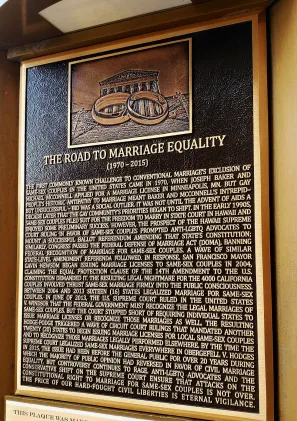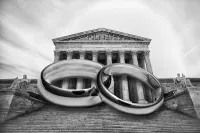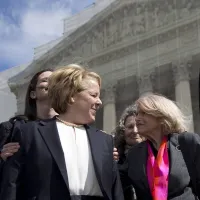-
United States v. Windsor & Obergefell v. Hodges SCOTUS Rulings Strike Down the Defense of Marriage Act
"DOMA undermines both the public and private significance of state-sanctioned same-sex marriages; for it tells those couples, and all the world, that their otherwise valid marriages are unworthy of federal recognition. This places same-sex couples in an unstable position of being in a second-tier marriage. The differentiation demeans the couple…. And it humiliates tens of thousands of children now being raised by same-sex couples.”
- Justice Anthony Kennedy’s majority opinion striking down Section 3 of the Defense of Marriage Act
"No union is more profound than marriage, for it embodies the highest ideals of love, fidelity, devotion, sacrifice, and family. In forming a marital union, two people become something greater than once they were. As some of the petitioners in these cases demonstrate, marriage embodies a love that may endure even past death. It would misunderstand these men and women to say they disrespect the idea of marriage. Their plea is that they do respect it, respect it so deeply that they seek to find its fulfillment for themselves. Their hope is not to be condemned to live in loneliness, excluded from one of civilization’s oldest institutions. They ask for equal dignity in the eyes of the law. The Constitution grants them that right."
- Justice Anthony Kennedy’s majority opinion making marriage equality the law of the land
The first commonly known challenge to conventional marriage’s exclusion of same-sex couples in the United States came in 1970, when Joseph Baker and Michael McConnell applied for a marriage license in Minneapolis, MN. But gay people’s historic antipathy to marriage as a failed heterosexual institution, meant Baker and McConnell’s intrepid – but unsuccessful – bid was a social outlier. It was not until the advent of AIDS a decade later that the gay community’s priorities began to shift. In the early 1990s, the prospect of same-sex marriage being adopted in Hawaii prompted Congress to pass the federal Defense of Marriage Act (DOMA) – a torturously assembled collection of Anti-Same-Sex-Marriage statutes. Enticed by conservative voters’ strident antipathy to most anything involving gay people, President George W. Bush threw his support behind a constitutional amendment limiting federal marriage to one man and one woman. A wave of similar state-level amendment referenda followed. In response, San Francisco Mayor Gavin Newsom began issuing marriage licenses to same-sex couples in 2004, claiming the Equal Protection Clause of the 14th Amendment to the U.S. Constitution demanded it. The resulting legal nightmare thrust Same-Sex Marriage into the public consciousness. Between 2004 and 2013 sixteen (16) states legalized same-sex marriages one way or another. In June of 2013, the U.S. Supreme Court ruled in the United States v. Windsor that the federal government must recognize the legal marriages of homosexual couples. But the court stopped short of requiring individual states to recognize those marriages as well. The resulting hodge-podge triggered a wave of individual Circuit Court rulings that forced another twenty (20) states to begin issuing marriage licenses for local same-sex couples while recognizing those marriages legally performed elsewhere. By the time the Supreme Court legalized same-sex marriages everywhere in Obergefell v. Hodges in 2015, the issue had been before the general public for over 20 years. During that time the majority of public opinion had reversed in favor of civil marriage equality. But controversy continues to rage. The conservative shift on the Supreme Court under Donald Trump ensured that nationwide Marriage Equality would be challenged on the basis that forced recognition of such marriages would constitute an infringement on the free exercise of religion. The price of our hard-fought civil liberties is eternal vigilance.
Longer version not on the Legacy Walk plaque below
Though marriage equality is a contemporary shock to the senses for a lot of people, there is a rich and varied history for the ritualized codification of same-sex relationships. The ancient Greeks had the rite of Adelphopoiesis – a form of “brother-making” that joined two men together in a ceremony that contained every element of the traditional marriage nuptial. Similarly, in Medieval through late Renaissance Europe there existed the rite of Wedded Brotherhood – which, again, used most all the elements of the traditional marriage ceremony to join two men to each other. (Similar rituals existed for women.) Though undoubtedly many of the people who participated in these ritual “joinings” were not sexually involved, it would be naïve in the extreme to presume none of them were. History has shown that these unions existed quietly (and, in many cases, openly) alongside “conventional” marriage, forming a complex matrix of different, but accepted, relationships within older societies.
So when ONE Magazine’s August 1953 issue debuted with the title “Homosexual Marriage?” on the cover, it both echoed the past and foreshadowed the future. The first commonly known U.S. challenge to conventional marriage’s exclusion of same-sex couples came in 1970, in Minneapolis, when Joseph Baker and Michael McConnell applied for a marriage license. Though turned down by Hennepin County, they fought their case all the way to the U.S. Supreme Court. Baker and McConnell were generally seen as anomalies, as most gay activists – caught up in a burgeoning sexual revolution – viewed “gay marriage” as a paternalistic and stifling embrace of a failed heterosexual institution. A decade later, the advent of AIDS triggered a realignment of the LGBT community’s historic antipathy to marriage when the estranged families of dying homosexual men surfaced to deny hospital visitation to their lovers, to abrogate survivors’ rightful inheritance of assets, and to drive them from the homes they had shared.
In the early 1990s the prospect of same-sex marriage being adopted in Hawaii prompted Congress to pass the federal Defense of Marriage Act (DOMA) by overwhelming bipartisan majorities in both houses of Congress in 1996. DOMA was signed into law by President Bill Clinton with two hugely problematic provisions: Section 2 provided that states would not be required to recognize same-sex marriages from other states, and Section 3 provided that for all purposes under federal law, marriage would be defined only as the union of one man and one woman. Buoyed by the prospect of conservative voter election turnout being fueled by a fear of same-sex marriage, on February 24, 2004 President George W. Bush threw his support behind a constitutional amendment limiting federal marriage laws to one man-one woman, prompting a massive nationwide campaign to modify state constitutions as well.
In response, San Francisco Mayor Gavin Newsom began issuing marriage licenses to same-sex couples in 2004, claiming the restriction of marriage to only one man and one woman violated the Equal Protection clause of the 14th Amendment to the U.S. Constitution. About 4000 such licenses were issued between February 12 and March 11, 2004 before the California Supreme Court ordered a halt to the practice. On August 12th the Court voided all of the licenses that had been issued. The resulting legal dispute led to a 2008 California Supreme Court declaration legalizing same-sex marriage in the state. The move stunned traditionalists, prompting the drive to place the “Prop 8” voter referendum on the ballot, whose eventual passage banned same-sex marriage, while also triggering a seven-year legal fight that would eventually change the course of history.
Lost amidst all the drama in California was Massachusetts’s Supreme Court authorizing the legalization of same-sex marriage in 2004 – quietly beginning a stunning shift in Americans’ perception of the issue, first through court order, then through electoral action. Between 2004 and 2013 sixteen (16) states legalized same-sex marriages one way or another. In June of 2013, in the case of the United States v. Windsor, the U.S. Supreme Court ruled that the federal government must recognize the legal marriages of homosexual couples regardless of which state they were performed in, or in which state the couples currently resided. But the court stopped short of requiring individual states to recognize those marriages as well.
The resulting hodge-podge meant that a legally married couple could be rendered un-wed – and potentially lose their children – if they resettled in the wrong state. The court’s Windsor decision (in tandem with its refusal to overturn the federal appellate court’s nullification of California’s Prop 8) triggered a wave of individual Circuit Court rulings across the country that forced another twenty (20) states to begin issuing marriage licenses for local same-sex couples while recognizing those marriages legally performed elsewhere. By the time the Supreme Court ruled in Obergefell v. Hodges (2015) – effectively legalizing same-sex marriage everywhere – the issue had been before the general public for over 20 years. During that time a mixture of familiarity/boredom with the subject, a growing awareness of the travails same-sex couples were forced to endure, and the maturation of new generation’s liberal attitudes, prompted a reversal of public opinion in favor of civil marriage equality.
In spite of the Supreme Court’s historic Obergefell decision, controversy continues to rage. A wave of “Religious Freedom” laws have been proposed to allow any person or business to circumvent all pro-LGBT legislation or court directives – including civil marriage – on the basis that compliance with such laws would constitute an infringement on the free exercise of religion. Regionally clustered, and politically motivated, these tactics may temporarily bear fruit – not unlike those anti-same-sex-marriage state constitutional voter initiatives in the mid-2000s; but the continued advance of progressive beliefs among young people everywhere, coupled with successful court challenges to overly broad interpretations of “religious freedom” ensure our opponents will not prevail. Marriage Equality is the law of the land – proving the U.S. Constitution works for everybody – but the price of our hard-fought civil liberties is eternal vigilance.
Demography
Nations Affiliated Afghanistan United States
Era/Epoch Information Age (1970-present)
Resources












